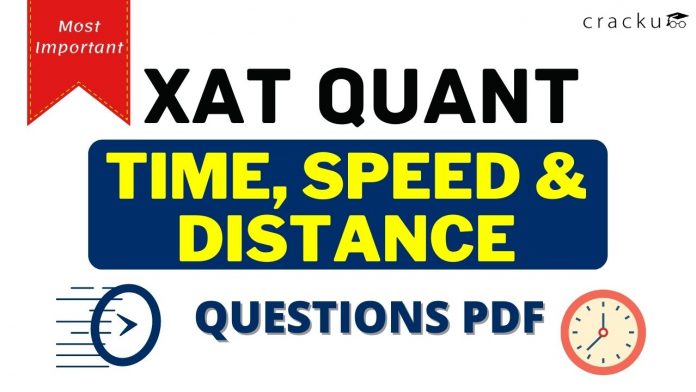XAT Speed Time and Distance Questions [PDF]
Download Speed Time and Distance Questions for XAT PDF – XAT Speed Time and Distance questions pdf by Cracku. Practice XAT solved Speed Time and Distance Questions paper tests, and these are the practice question to have a firm grasp on the Speed Time and Distance topic in the XAT exam. Top 20 very Important Speed Time and Distance Questions for XAT based on asked questions in previous exam papers. The XAT question papers contain actual questions asked with answers and solutions.
Download Speed Time and Distance Questions for XAT
Enroll to XAT 2023 Crash Course
Question 1: A person crosses a 900-metre long street in 6 minutes.The speed of the person in km/h is:
a) 9
b) 10
c) 15
d) 12
1) Answer (A)
Solution:
Distance travelled = 900 m = $\frac{900}{1000}=0.9\ km$
Time taken = 6 minutes = $\frac{6}{60}=\frac{1}{10\ }=0.1\ hr$
Speed of person (km/hr) = $\frac{Dis\tan ce}{time\ }=\frac{0.9}{0.1}$
= 9 km/hr
Hence, Option A is correct.
Question 2: A train can travel 40% faster then a car.Both the train and the car start from point A at the same time and reach point B, which is 70km away point from A,at the same time.On the way, however,the train lost about 15 minutes while stopping at stations. The speed of the car in km/h is:
a) 120
b) 80
c) 90
d) 100
2) Answer (B)
Solution:
let the speed of car be x.
then the speed of train = $x\left(1+\frac{40}{100}\right)=1.4x$
Time taken by car to cover 70km = $\frac{70}{x}$
Time taken by train to cover 70km = $\frac{70}{1.4x}=\frac{50}{x}$
According to question,
$\therefore\ \frac{70}{x}-\frac{50}{x}=\frac{15}{60}$
$\therefore\ \frac{20}{x}=\frac{1}{4}$
so, Speed of car = x = 80 km/hr
Hence, Option B is correct
Question 3: A man and a woman, working together can do a work in 66 days. The ratio of their working efficiencies is 3 : 2. In how many days 6 men and 2 women working together can do the same work?
a) 18
b) 15
c) 14
d) 12
3) Answer (B)
Solution:
Let the total work be 330 units.
Efficiency of a man and a woman together = $\frac{330}{66}$ = 5 units/day
The ratio of the working efficiencies of man and woman is 3 : 2.
Efficiency of a man = 3 units/day
Efficiency of a woman = 2 units/day
Efficiency of 6 men and 2 women together = (6 x 3) + (2 x 2) = 22 units/day
Time required for 6 men and 2 women together to complete the work = $\frac{330}{22}$ = 15 days
Hence, the correct answer is Option B
Question 4: A man and a woman, working together can do a work in 66 days. The ratio of their working efficiencies is 3 : 2. In how many days 6 men and 2 women working together can do the same work?
a) 18
b) 15
c) 14
d) 12
4) Answer (B)
Solution:
Let the total work be 330 units.
Efficiency of a man and a woman together = $\frac{330}{66}$ = 5 units/day
The ratio of the working efficiencies of man and woman is 3 : 2.
Efficiency of a man = 3 units/day
Efficiency of a woman = 2 units/day
Efficiency of 6 men and 2 women together = (6 x 3) + (2 x 2) = 22 units/day
Time required for 6 men and 2 women together to complete the work = $\frac{330}{22}$ = 15 days
Hence, the correct answer is Option B
Question 5: A train is to cover 370 km at a uniform speed. After running 100 km,the train could run at a speed 5 km/h less than its normal speed due to some technical fault. The train got delayed by 36 minutes. What is the normal speed of the train, in km/h?
a) 48
b) 45
c) 40
d) 50
5) Answer (D)
Solution:
Let the normal speed of the train = s km/h
According to the problem,
$\frac{100}{s}+\frac{270}{s-5}=\frac{370}{s}+\frac{36}{60}$
$\frac{270}{s-5}-\frac{270}{s}=\frac{3}{5}$
$90\left[\frac{s-s+5}{\left(s-5\right)s}=\frac{1}{5}\right]$
$s^2-5s-2250=0$
s = 50 or s = -45
‘s’ cannot be negative.
So s = 50 km/h
Normal speed of the train = s = 50 km/h
Hence, the correct answer is Option D
Question 6: A train running at $40\frac{1}{2}$ km/h takes 24 seconds to cross a pole. How much time (in seconds) will it take to pass a 450 m long bridge?
a) 56
b) 52
c) 60
d) 64
6) Answer (D)
Solution:
Let the length of the train = L
Speed of the train = $40\frac{1}{2}$ km/h = $\frac{81}{2}$ km/h = $\frac{81}{2}\times\frac{5}{18}$ m/sec = $\frac{45}{4}$ m/sec
Train crosses a pole in 24 seconds.
$\frac{L}{\frac{45}{4}}$ = 24
$\frac{4L}{45}$ = 24
L = 270 m
Length of the train = L = 270 m
Time required for train to pass a 450 m long bridge = $\frac{L+450}{\frac{45}{4}}$
= $\frac{270+450}{\frac{45}{4}}$
= $\frac{720\times4}{45}$
= 64 sec
Hence, the correct answer is Option D
Question 7: A and B can do certain work in 18 days and 30 days,respectively. They work together for 5 days. C alone completes the remaining work in 15 days. A and C together can complete $\frac{5}{6}$th part of the same work in:
a) 6 days
b) 8 days
c) 9 days
d) 5 days
7) Answer (C)
Solution:
Let the total work = 360 units
Efficiency of A = $\frac{360}{18}$ = 20 units/day
Efficiency of B = $\frac{360}{30}$ = 12 units/day
A and B worked together for 5 days.
Work done by A and B together in 5 days = 5 x (20 + 12) = 160 units
Remaining work = 360 – 160 = 200 units
C alone completes the remaining work in 15 days.
Efficiency of C = $\frac{200}{15}$ = $\frac{40}{3}$ units/day
Efficiency of A and C together = 20 + $\frac{40}{3}$ = $\frac{100}{3}$ units/day
$\frac{5}{6}$th of the total work = $\frac{5}{6}\times$360 = 300 units
Number of days required for A and C together to complete $\frac{5}{6}$th of work = $\frac{300}{\frac{100}{3}}$
= $\frac{300\times3}{100}$
= 9 days
Hence, the correct answer is Option C
Question 8: A can complete a work in $11\frac{1}{2}$ days. B is 25% more efficient than A and C is 50% less efficient than B. Working together A, B and C will complete the same work
a) 5 days
b) 4 days
c) 3 days
d) 8 days
8) Answer (B)
Solution:
Let the total work = 460 units
A can complete a work in $11\frac{1}{2}$ days.
Efficiency of A = $\frac{460}{\frac{23}{2}}$ = 40 units/day
B is 25% more efficient than A.
Efficiency of B = $\frac{125}{100}\times40$ = 50 units/day
C is 50% less efficient than B.
Efficiency of C = $\frac{50}{100}\times50$ = 25 units/day
Efficiency of A, B and C together = 40 + 50 + 25 = 115 units/day
Number of days required for A, B and C together to complete the work = $\frac{460}{115}$ = 4 days
Hence, the correct answer is Option B
Question 9: A train covers 450 km at a uniform speed. If the speed had been 5 km/h more, it would have taken 1 hour less to cover the same distance. How much time will it take to cover 315 km at its usual speed?
a) 7h 52m
b) 6h 30m
c) 6h 18m
d) 7h
9) Answer (D)
Solution:
Let the uniform speed of train = s
According to the problem,
$\frac{450}{s+5}=\frac{450}{s}-1$
$\frac{450}{s}-\frac{450}{s+5}=1$
$450\left(\frac{s+5-s}{s\left(s+5\right)}\right)=1$
$450\left(\frac{5}{s^2+5s}\right)=1$
$s^2+5s-2250=0$
$\left(s+50\right)\left(s-45\right)=0$
s = -50 or s = 45
s cannot be negative, so s = 45 km/h
The uniform speed of train = 45 km/h
Time taken by train to cover 315 km at its usual speed = $\frac{315}{45}$ = 7 hours
Hence, the correct answer is Option D
Question 10: A train running at 48 km/h crosses a man going with the speed of 12 km/h, in the same direction, in 18 seconds and passes a woman coming from the opposite direction in 12 seconds. The speed (in km/h) of the woman is :
a) 6
b) 8
c) 9
d) 10
10) Answer (A)
Solution:
Let the length of the train = L
Relative speed between train and man = 48 – 12 = 36 km/h
= 36 x $\frac{5}{18}$ m/sec
= 10 m/sec
Time taken by train to cross the man = 18 seconds
$\frac{L}{10}$ = 18
L = 180 m
Length of the train = 180 m
Let the speed of the woman = s km/h
Relative speed between train and woman = (48 + s) km/h
= (48 + s) x $\frac{5}{18}$ m/sec
Time taken by train to cross the woman = 12 seconds
$\frac{L}{\left(48+s\right)\times\frac{5}{18}}=12$
$\frac{180}{\left(48+s\right)\times\frac{5}{18}}=12$
$\frac{180\times18}{\left(48+s\right)5}=12$
48 + s = 54
s = 6
Speed of the woman = 6 km/h
Hence, the correct answer is Option A
Question 11: A car can cover a distance of 144 km in 1.8 hours. In what time(in hours) will it cover double the distance when its speed is increased by 20% ?
a) 3
b) 2.5
c) 2
d) 3.2
11) Answer (A)
Solution:
Speed of the car = $\frac{144}{1.8}$ = 80 km/hr
Speed of the car when increased by 20% = $\frac{120}{100}\times$80 = 96 km/hr
Required time = $\frac{288}{96}$
= 3 hours
Hence, the correct answer is Option A
Question 12: To do a certain work, efficiencies of A and B are in the ratio 7:5. Working together, they can complete the work in $17\frac{1}{2}$ days. In how many days, will B alone complete 50% of the same work?
a) 42
b) 21
c) 15
d) 30
12) Answer (B)
Solution:
Let the total work = 700 units
Efficiencies of A and B are in the ratio 7:5.
Let the efficiency of A and B are 7p and 5p respectively.
Efficiencies of A and B together = 7p + 5p = 12p units/day
Working together, they can complete the work in $17\frac{1}{2}$ days.
$\frac{700}{12p}$ = $17\frac{1}{2}$
$\frac{700}{12p}$ = $\frac{35}{2}$
p = $\frac{10}{3}$
Efficiency of B = 5p = $\frac{50}{3}$ units/day
Number of days required for B alone complete 50% of the same work = $\frac{350}{\frac{50}{3}}$
= $\frac{350\times3}{50}$
= 21 days
Hence, the correct answer is Option B
Question 13: A boat goes 30 km upstream in 3 hours and downstream in 1 hour. How much time (in hours) will this boat take to cover 60 km in still water?
a) 6
b) 3
c) 2
d) 5
13) Answer (B)
Solution:
Let the speed of the boat in still water = m
Speed of the stream = s
Upstream speed = m – s
$\frac{30}{3}$ = m – s
m – s = 10…………(1)
Downstream speed = m + s
$\frac{30}{1}$ = m + s
m + s = 30………..(2)
Adding (1) and (2),
2m = 40
m = 20
Speed of the boat in still water = 20 km/h
Time required for the boat to cover 60 km in still water = $\frac{60}{20}$ = 3 hours
Hence, the correct answer is Option B
Question 14: A is twice as good a workman as B and together they finish a piece of work in 22 days. In how many days will A alone finish the same work?
a) 30 days
b) 44 days
c) 33 days
d) 11 days
14) Answer (C)
Solution:
Let the total work = W
A is twice as good a workman as B
Let the number of days required for A alone to complete the work = a
$\Rightarrow$ Number of days required for B alone to complete the work = 2a
Work done by A in 1 day = $\frac{W}{a}$
Work done by B in 1 day = $\frac{W}{2a}$
Given, A and B together finish the work in 22 days
$\Rightarrow$ Work done by A and B together in 1 day = $\frac{W}{22}$
$\Rightarrow$ $\frac{W}{a}$ + $\frac{W}{2a}$ = $\frac{W}{22}$
$\Rightarrow$ $\frac{3}{2a}$ = $\frac{1}{22}$
$\Rightarrow$ a = 33
$\therefore\ $Number of days required for A alone to complete the work = 33 days
Hence, the correct answer is Option C
Question 15: The speed of a train is 220% of the speed of a car. The car covers a distance of 950 km in 19 hours. How much distance will the train cover in $3 \frac{1}{2}$ hours?
a) 380 km
b) 385 km
c) 375 km
d) 285 km
15) Answer (B)
Solution:
Speed of the car = $\frac{950}{19}$ = 50 km/h
Given, speed of the train is 220% of the speed of the car
$\Rightarrow$ Speed of the train = $\frac{220}{100}\times50$ = 110 km/h
$\therefore\ $Distance covered by the train in $3 \frac{1}{2}$ hours = $110\times3\frac{1}{2}$ = $110\times\frac{7}{2}$ = 385 km
Hence, the correct answer is Option B





